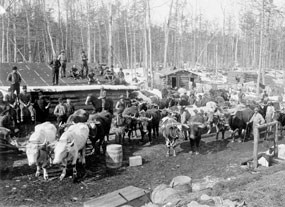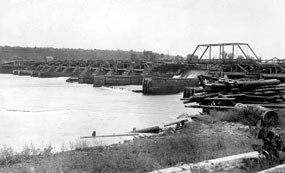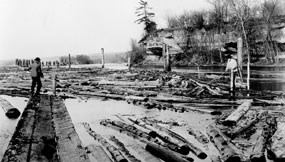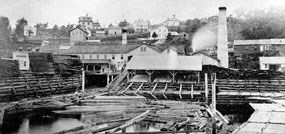|
Within the St. Croix Watershed during the logging era (1839-1914) all aspects of the logging industry from tree to finished product could be found. Along the river the pines, often old and large stood to be cut in winter with ax and later saws. Banked on the riverbank and released in spring with the melt the logs were driven downriver to sawmills or made into rafts to be floated to the Mississippi River. 
Minnesota Historical Society Logging CampsThe logging industry began here prior to settlement. While logging and settlement grew together, the best pine logs of the St. Croix were typically located in regions that were far from towns. To access these trees, "lumber barons" and other ambitious small-scale frontiersmen built logging camps in the fall that were closest to the best stands of pine. These managers then hired crews of lumberjacks to fell, stack and float the pine down river to mill and market. Each camp was only used for a couple of years until the pine was cut down, and then the camp would be moved closer to another stand. In the early 1830s and 1840s, these logging camps were usually small operations, close to the rivers that supplied cheap transportation. Each outfit might employ a dozen or so lumberjacks living in a single log-built shanty that functioned as a bunkhouse, mess hall and supply store. They would also have several teams of oxen for pulling logs to the riverbank. By the 1870s, as the pinery receded further from the floatable rivers and lumberman began to buy larger stands of pine, more labor was needed to get the logs out of the woods. The largest crews employed hundreds of men and the logging camps became small settlements of multiple buildings including mess halls, bunkhouses, supply warehouses, a blacksmith shop and perhaps barns for housing draft animals. As the logging camps became bigger, they also became more expensive and only larger lumber firms could afford the expense. However that expense did not deter the industry from expanding. In the beginning of the era, there might be 50 or so smaller logging camps in the valley, however by the 1880s there could easily be over 150 camps in the valley during any given winter. None of the camps have been preserved and most were beyond the narrow boundaries of the Riverway, but their impact can still be seen today. The most obvious is many of the white pine growing along the river are approaching 100+ years of age, for that is how long ago the logging era was. VeazieAs the St. Croix pinery receded further and further from the navigable river way, the largest problem facing lumbermen was keeping logging camps supplied. In the late-1860s, some logging companies built supply depots and farms to function as regional hubs for logging operations in the furthest reaches of the watershed. These farms would be stocked with goods and food brought by wagon from Taylors Falls, which could still receive supplies by steamboat in the early fall months. From the farms, loggers and lumberjacks could purchase supplies closer to their camps and during the summer, they could pay a fee to house their draft animals. Frequently these locations were the earliest settlements in the more remote areas of the St. Croix valley. One such farm was located near the modern day town of Trego Wisconsin on the Namekagon River, some hundred river miles above the head of steamboat navigation. The "Namekagon Farm" was built as early 1868, by the Marine-on-St. Croix firm of Walker, Judd and Veazie, which was also the first company to operate a sawmill in the valley in 1839. The "Namekagon Farm" soon became the center of activity on the Namekagon River, eventually expanding to become a full-fledged settlement with a saloon, jail, post office, hotel/general store black smith and barns. Popularly known as "Veazie," it became the first incorporated town on the Namekagon in 1880. By 1878, a dam was also built near the location to facilitate spring log drives. Veazie fell into decline by 1884, when Walker, Judd and Veazie declared bankruptcy. Their spring log drive became hung up in the increasingly common logjams at the St. Croix Dalles' "Angle Rock," a promontory face of trap rock near Taylor's Fall creating a sharp right turn in the river. The long duration of the jam, caused by the massive flow of logs coming out of the valley froze business in the valley, as no company was able to pay its creditors or employees until it had sawed and sold their timber. Walker, Judd and Veazie was unable to fulfill its lumber contracts and went belly-up. The town of Veazie became controlled by smaller local interests until it ultimately faded away in the early 1900s when the railroad made other settlements on the Namekagon more important and there was no longer any pine in the region. The remains of the town were removed in 1955 to make pasture land and the only remnants are the ruins of the dam that washed out in 1903 which can still be seen if one looks. 
Sanford C. Sargent, MN Historical Society Nevers DamAs the problem of log jams at "Angle Rock" in the Dalles, became stifling in the 1880s, lumbermen devised new solutions to rationalize and control the flow of logs to their mills. While some began to shift to using railroad transportation, Frederick Weyerhaeuser, a mastermind of corporate organization in the lumber industry, undertook a more ambitious plan to control the river. In 1889, he began to build Nevers Dam, eleven miles upstream from "Angle Rock." The dam was 614 feet across and reported to be the largest wood pile driven structure in the world costing over $250,000 to build. As a large bear-trap gate dam, Nevers created an fifteen mile flowage that allowed the lumbermen to control the number of logs that would reach "Angle Rock" and thus prevent log jams. The dam even had electric lights installed to allow for 24-hour log sluicing. As an extension of the St. Croix Boom Company, Nevers Dam further allowed a select few to charge rates on every log that flowed through and thus limit the number of competitors in the Valley. The dam was pulled out in 1955, but the earth works and ice breaker islands are still visible near Nevers Dam Landing located off of River Road or Wild River State Park. More than the successful consolidation of business interests in the valley however, Nevers Dam represented the completion of human control of the river. Throughout the logging era, lumberman strove to rationalize the flow of water. Clearing and straightening streams and erecting dams, the lumbermen increased the drivable river of the watershed from less than one hundred miles in 1840 to over 840 in 1900. As part of this transformation between 60-70 gated dams were built on the St. Croix River and its tributaries, not to mention hundreds of temporary splash dams. Every spring, loggers systematically drove their logs down river, utilizing dams to create a head of water to power the logs to market.

John Runk, MN Historical Society BoomsiteEvery logging camp stacked its winter cut by the rivers, waiting for the ice to break so that "river pigs" could drive logs to mill and market further down river. With upwards of 150 camps functioning in the valley, it was expected that logs would intermix. To resolve the confusion, every lumber camp had a unique log mark, which they used to brand the ends of their logs. They also adopted a system from New England for sorting the logs at a centralized location called a boom. Initially used in Maine, but later brought to practically every major logging river in the Midwest, a log boom was a fence made of logs chained end to end across a river and anchored to banks and streambed. A boom would have a crew armed with pikes to sort out the logs by brand, placing them in holding cribs. Because of the amount of money that was needed to build and run a boom, lumbermen usually secured charters from state governments to give them the right to charge a fee for their sorting services. The St. Croix Boom Company, nicknamed "the Octopus," was founded in 1851 and was initially built near Osceola, WI. The company's charter from the Minnesota Territorial Government gave them the right to charge 40 cents per thousand board feet they sorted. In 1856 the boom was relocated just above Lake St. Croix: closer to the sawmills of Stillwater and below the mouth of the Apple River, a major pinery. With so much logging going on in the valley at upward of 150 camps, it was not uncommon for a 15 mile backup of logs to form for sorting at the boom every spring/summer by the 1880s. The St. Croix Octopus was a source of wealth and power to the few lumbermen that owned stock. The charter effectively allowed the boom to tax every log that came out of the valley on the water. 
John Runk, MN Historical Society SawmillsWhile the largest number of sawmills were in Stillwater there were more mills both up and down stream. The first sawmill to operate was in Marine on Saint Croix. Known as the Marine Lumber Company, the sawmill cut its first pine log in August of 1839 and became the first commercial sawmill along the St. Croix River. The sawmill, first run by waterpower and later by steam, operated under many names and owners and milled more than 197 million board feet of lumber before it closed in 1895. Today you can visit remains of the sawmill's stone foundations. Interpretive signs, pathways, and an overlook above the ruins help to explain the mill and its history. A chimney from the mill at Arcola still exists, but most of the other mill sites such as St. Croix Falls and Franconia are long gone. The Namekagon River also had both large and small mills. The Radloff mill was a small mill below Cable while the Hayward Mill was equal to the big mills in Stillwater. It began operating in 1883 and employed 250-300 people, sawing 25-45 million board feet a year. StillwaterWith the relocation of the boom in 1857, Stillwater became the effective economic center of the valley. Prior to the creation of the boom, the site already had several saw mills, the first being built in 1844 and was a natural congregating point at the top of Lake St. Croix for river pilots that floated assembled rafts of logs and lumber downriver to destinations like Rockport and St. Louis. However, other locations up river had better natural advantages in water current to power saw mills and were closer to the logging camps, offering more convenient locations to buy supplies. Once the boom was moved, however, Stillwater effectively became the head of steamboat navigation. No steamboat traffic could get around the logs at the boom, limiting upriver to only 3 months in late summer and early fall. As the choke point for river navigation as well as logging in the watershed, Stillwater quickly became the largest town in the valley. In the 1860s, greater investment in steam-powered sawmills supplanted water mills in the valley. More than 12 such mills were built in Stillwater that could cut timber year round and faster. Laborers congregated in Stillwater to find jobs in the mills, on the booms, piloting lumber rafts and looking to join logging crews going to the woods for the winter. The town also became the major place for those laborers to spend their wages, supporting as many as 25 saloons and many other business and temporary housing for the mobile workforce of the valley. As the base of logging operations in the watershed, Stillwater was also the heart of business and political decision-making in the valley. In Stillwater, lumbermen not only found labor, but planned new business ventures, plotted optimum strategies for securing pine land stumpage, cooperated to finance dams to improve the river for logging drives, organized agents to sell their logs in distant markets down river and organized political lobbies to create market advantages. As the decades passed, a few Stillwater lumbermen consolidated control of the St. Croix pinery through devising strategies to either tax use of the river by others through dams and notably the boom or finding cheaper ways to get pine by purchasing land warrants or railway grants in massive quantities. By the 1880s, the amount of capital necessary to remain competitive in the logging industry of the St. Croix became prohibitively expensive for all but a few to run successful logging operations. Some of the opulent Victorian homes of Stillwater lumbermen still stand in the town as monuments to their prominence in the valley. |
Last updated: October 17, 2021

